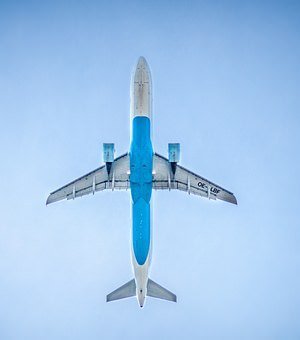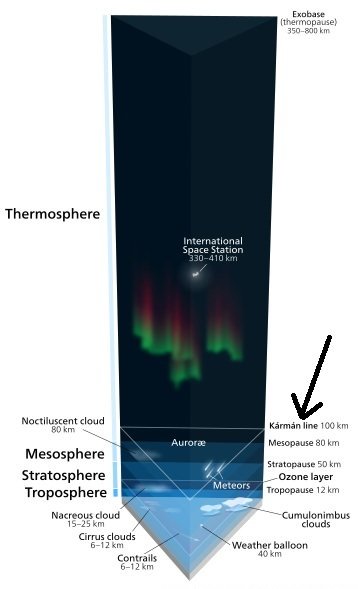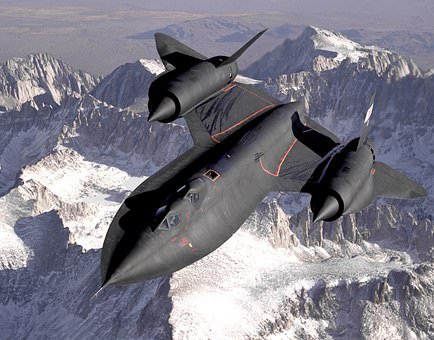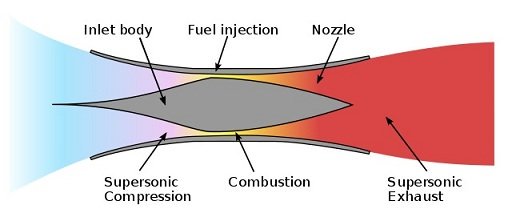Let's Fly An Airplane Into Space - [Possibility or Futility?]
Introduction
Ladies and Gentlemen, this is flight number 12-07-18, I am your Captain @samminator, and we are enroute to "space"... blah, blah, blah. Did someone just ask; "space?" Okay I know what's in your mind right now - How da heck do you hope to fly a damn plane into space? Is this even possible? Before you answer in the affirmative or negative, just hang on for a while, let me you on a little flight, but do ensure you fasten your seatbelts, because this would be one hell of a flight.

[Image Source: Pixabay. CC0 licensed]
Space travel has been one of man's mind-blowing achievements; and this trail was blazed when Yuri Alekseyevich Gagarin broke the record to become the first man in space in the year 1961 [ref], and ever since then, space travels have been happening every now and then. But if you have kept close tabs of all of them, you would have discovered that they were made possible by rocket-propelled space shuttles; then one could ask, why must it be a rocket and not an airplane, since airplanes can fly high into the sky?
First of all, we will look at the aerodynamics and general principle of how planes fly; by the time we're through, you would have had your answers. I would try to make this as simple as possible. We will first bring in a very important factor - "air". Some may have looked at air as some bunch of light-weight stuff; yes this is correct; but the large wings of the airplane is shaped in such a way that; when an airplane is airborne, the streams of air passing through them would be pretty fast, which creates the upthrust to keep the plane in the atmosphere, and helps to create the needed lift for the plane - and the process continues: The wings cause the streams of air to be faster, the air creates the needed upthrust, and the plane gets higher.
But like you may have been aware of from your elementary physics; when you keep going higher into the atmosphere, the air becomes less dense and the oxygen level drops (that is the reason mountain-climbers normally use oxygen mask while approaching the summit of high mountains). When the airplane get to a certain altitude above the sea level, the air becomes extremely thin. Note: For the normal passenger aircraft; they are usually kept at the average range of 12km above sea level [ref] - for this same purpose. But for the plane to be able to go higher than this, there is a requirement for an increase in speed, so as to maintain the upthrust.
Remember, at this point, the space is not even in-view. To make things clearer, "space" has not been given a definitive starting point; in terms of distance from the earth's sea level; but any distance above the Kármán line (which has been used to represent the boundary between space and earth) can be called space, and this line is at 100km from the sea level [ref]. Maybe this image would give you more insight.

[Layers of the atmosphere, showing the Kármán line. Sourc: Wikimedia Commons. Author: Kelvinsong. CC BY-SA 3.0 licensed]
It is also worthy to note that "air" is almost completely devoid as you approach space (that is why space is a vacuum), and remember what I told you about air providing the upthrust for the plane. Not only that, air aids in the combustion that happens in an airplane engine - so as humans would; of necessity; require oxygen to be alive, airplane engines also need it for combustion. Now, while the plane gets to the point where the air is almost completely thinned out, what do you think the engines would do? Don't guess yet; just hang on. Just so you'd be aware, one of the highest flying manned aircrafts to have graced the atmosphere is the Lockheed SR-71 Blackbird, with a relative altitude of a whopping 25km above sea level [ref]. But this is still not up to the standardized Kármán line of 100km. But even at the height of 25km from the sea level, the air would be extremely thin, and for the Blackbird to achieve this, it has to be moving extremely fast - and this is at the record-breaking speed of over 2,193.13Miles/hr [ref] - that's over 3times the speed of sound, which is also the fastest ever manned aircraft (okay, the truth is this; the pilot has to have an oxygen mask, otherwise, he'll just enter into hypoxia and pass out).

[Lockheed SR-71 Blackbird. Source: Pixabay. CC0 licensed]
Someone could ask, "isn't this fast enough to get into space?" Have you ever considered another important factor - "escape velocity"? This is actually the velocity required to break through the gravitational influence of the earth before entering the space, and this is at roughly 25,000miles/hr [ref], and remember, our darling Blackbird had the top speed of just over 2,193Miles/hr. How da heck does the Blackbird hope to break through the gravitational influence with that speed? Even though some modifications have been made to the design, to produce an aircraft called; NASA X-43, which is fully unmanned and can go at a much faster speed of Mach9 (9 times the speed of sound), this is achieved because they are fitted with a particular engine known as Scramjet Engine, which supports air compression at high speed.

[Internal operation of Scramjet Engine. Source: Wikimedia Commona. Author Luke490. CC BY-SA 3.0 licensed]
But as it were, even the scramjet requires oxygen to "breath", but space lacks oxygen, so scramjet has been ruled out of the way for space trips. What other engines are in contention? Oh! Rocket engine it is. Are there differences in the principles and workings of jet engines and rocket engines? Also, is it possible for rocket engines to be fitted in airplanes?
Jet Engine VS Rocket Engine
Just like I mentioned above, the jet engine would require external oxygen for the combustion; which is also its major disqualification for space trips (because of lack of oxygen there), but rocket brings its own required oxygen for combustion of fuel; which makes it not to depend on the air from the atmosphere. That is why space shuttles are equipped with rocket packs.
Coming to my next question: Can't these rocket engines be incorporated into airplanes, so they can take off from the runway and boom!! fly into space? Okay, fair enough; the answer is in the affirmative, and the right technology has arisen. A beast is about to be unleashed; the Skylon, which would combine the features of airplane and the feature of rocket in one unit (remember, the combustible packs in rockets are detachable), but in the case of Skylon, things would be a little different. Take a look at this YouTube video to see a simulation of how Skylon would operate
This beast is built with a "Single-staged orbit design" - in order words; unlike the regular rockets; the payloads are not detachable; and are incorporated into the plane (if I should call it that). But remember, rockets are normally positioned vertically, so the ignition and combustion of the payload would create a vertical thrust. But for Skylon, there has to be a lift first to the mid-air before triggering the rocket engines. So which engines would provide the lift? Oh; this would be done by the SABRE (Synergetic Airbreathing Rocket Engine). This; in a layman's term; is a hybrid, or rather, a combo of jet engine and rocket engine. So on take-off, the "jet engine" part of the SABRE (which breaths atmospheric air) would be initiated first, which will then shift to the rocket engine segment in mid-flight, and boom!!! it would be space-bound - straight to the damn space; after all, it is functioning in the same capacity as the normal rocket, and is not dependent on the air from the atmosphere (because it comes with its oxygen payload).
And awesomely enough, when coming back to the earth, the Skylon's SARBRE engine would switch back to airplane mode (after crossing the Kármán line), and it would land just like a normal plane would; on a runway. Now your interest has been piqued right? I know some would ask; when would this beast be unleashed? According to this report, the test flight is slated for 2025, and this could ultimately change the face of space travels. Maybe after that, going to space would be equated to normal flight on earth. And we could even consider holding a SteemSTEM meet-up somewhere in the space, lol.
Conclusion
Many people have been asking if you can fly into the space with an airplane, and more often than not, the answer is always a "no you can't", but I guess some ideas have been busted in this post, and you've gotten the answer you seek. So ladies and gentlemen, welcome to space, and I remain your captain @samminator.
Thanks for reading flying
References for further reading:
- Howstuffworks/Flight_principles
- Nasa.gov/How_Scramject_Engine_works
- How aiplanes fly
- Space.com/Skylon_SpacePlane
- Reactionengine.com/SABRE
- Principle of SABRE and Skylon
All Images are CC Licensed and are linked to their sources


gif by @foundation
The only way a plane can fly into space is if it has a rocket engine, and blasts off at incredible speeds to reach escape velocity. If it does all that, then it is no longer a plane but a rocket :)
That's why the Skylon is called "Space Plane". It hybridizes the normal jet engine and rocket engine. It would take off from the runway as a normal plane, and boooom!! It would attain rocket mode.
Did you watch the short video clip I provided buddy?
Thanks a lot for coming around
Hi @samminator!
Your post was upvoted by utopian.io in cooperation with steemstem - supporting knowledge, innovation and technological advancement on the Steem Blockchain.
Contribute to Open Source with utopian.io
Learn how to contribute on our website and join the new open source economy.
Want to chat? Join the Utopian Community on Discord https://discord.gg/h52nFrV
Wow
So when is our next flight to space?
Hahahaha, an interesting post you got here
Hopefully the year 2026 - A year after the launching of Skylon :p
Hope you're ready?
Hmm, but do we have to wait till 2025 since we already have captain @samminator?
Nice post there man, I'll like to watch this happen.
Well, except you don't want to fly in the Skylon.. :D
Thanks for coming bro
I must say, when I first saw the title of the post, all my knowledge from elementary physics were screaming not possible. I've always thought of the possibility, but I didn't know so much as been done already. Great post
There are many things that are now possible with the advances in tech; the word "impossible" might soon be phased out :p
One of my dreams is to go to space, and experience zero gravity.
I wonder if technology like the one in that engine can be used to make space tourism a reality someday in the future.
Sure buddy. This technology would give your dreams some boost.
See you in space
Please I don't want to fight ooo..... I always thought of it but not seeing the possibilities anytime soon
The rockets are still under development for better movement to space
Wow! You found it.. nice one man.
You've got an evolved brain
Thanks for coming around bro
lol... i'd like to see that...Good one
Sure. It would be great
This post has been voted on by the steemstem curation team and voting trail.
There is more to SteemSTEM than just writing posts, check here for some more tips on being a community member. You can also join our discord here to get to know the rest of the community!
Very nice post and very well explained!